
94% of researchers rate our articles as excellent or good
Learn more about the work of our research integrity team to safeguard the quality of each article we publish.
Find out more
ORIGINAL RESEARCH article
Front. Environ. Sci., 09 May 2023
Sec. Environmental Informatics and Remote Sensing
Volume 11 - 2023 | https://doi.org/10.3389/fenvs.2023.1193979
This article is part of the Research TopicAI and Data Analytics for Climate Data ManagementView all 9 articles
The present study tries to delineate groundwater zones in the Upper-Doab region of Uttar Pradesh, India based on its suitability for the use of domestic and irrigation purposes considering the physico-chemical parameters of groundwater samples (n ∼ 70) using Weighted Arithmetic Water Quality Index (WAWQI) and Composite Groundwater Quality Index for Irrigation (CGQII) methods, respectively. The Upper-Doab region of Uttar Pradesh is bounded by the mighty rivers of Ganga and Yamuna in the east and west respectively. In the southwest, the region shares the boundary with the national capital of Delhi, which has led to an increase in the growth of urbanization and industrialization in the region. These factors have a visible negative impact on the groundwater scenario of the region. Hydrogeochemical investigation reveals that the ionic dominance in the groundwater samples is in the order of HCO3 > Cl > SO4 > NO3 > F and Na > Mg > Ca > K. Chemical history of groundwater samples using piper-trilinear diagram shows that Ca-Mg-HCO3 and Ca-Na-HCO3 type of groundwater is mostly found in this region. Gibb’s plot reveals that rock-water interaction was dominantly controlling the ionic composition of the groundwater in the unconfined aquifer environment. Further, the bivariate plot of (SO4 + HCO3) vs. (Ca + Mg) reveals that the weathering of calcite and dolomite minerals present in the aquifer environment has largely attributed chemical character to the groundwater of the region. The groundwater zoning concerning its domestic and agricultural use reveals that the groundwater of Meerut, Muzaffarnagar, Baghpat, Ghaziabad, and Gautam Buddha Nagar districts have poorer quality of groundwater due to high electrical conductivity and higher concentration of nitrate which has a higher anthropogenic link. The evaluation of groundwater quality for irrigation using a single index value i.e., CGQII makes this study different from the other hydrochemical investigations under similar hydrogeolocal aquifer conditions in the region. The study suggests that corrective measures like, strict implementation of untreated discharge of industrial effluents to the water or groundwater directly, creating awareness among farmers for lesser use of chemical fertilizers, and regular groundwater monitoring systems for quality analysis must be considered for a sustainable future of the region.
The scarcity of food for the rapidly growing population of the world led to the introduction of the green revolution in the 1940s in the American continent and was followed by other countries of the world in the 1950s and 1960s (Wu and Butz, 2004). Most of these countries attained their objective within a decade after its implementation. In India, it started in the 1960s. But the country did not learn from the adverse effects of the green revolution from the regions like California where the groundwater crisis started way back in the 1970s (Schmidt, 2017). The green revolution coupled with rapid urbanization and industrial development led to an adverse impact on the groundwater regime of the world (McGrane, 2016).
Prevailing unhealthy practices to exploit natural resources in the processes of unsustainable development have not only polluted surface water resources but have also polluted underground resources (Rai and Saha, 2015; Lu et al., 2016). Groundwater i.e., one of the largest freshwater resources, that made civilization possible in those places which would otherwise remain uninhabited, is becoming a threat to human civilization in several places in the world. Various studies focusing on monitoring and assessment of the physico-chemical characteristics and subsurface water quality for drinking, industrial, and irrigation purposes raise a common concern for quantitative and qualitative decline of groundwater in various parts of the world (Amiri et al., 2014; Varol and Davraz, 2014; Singaraja, 2017; Kumari and Rai, 2020; Scheiber et al., 2020; Lalitha et al., 2021). Rapid urbanization and industrialization coupled with advancement in irrigation techniques and increased cultivation of water intensive crops have not only led to decline in groundwater table but also became a threat to groundwater quality (Lu et al., 2016; Megahed, 2020; Pant et al., 2021; Gautam et al., 2022; Lin et al., 2022; Patel et al., 2023). Worldwide, groundwater depletion has been estimated as 7,013 km3 i.e., approx. 137 km3 per year between 1960 and 2010 (Graaf et al., 2017). As per central groundwater board of India, about 17% of the groundwater blocks are over-exploited whereas, 5% and 14% are under critical and semi-critical conditions (Shiferaw, 2021). In the last few decades, groundwater has been polluted drastically because of increased human activities through changes in land-use/cover, agricultural practices, and intervention in natural flow patterns (Deshmukh, 2013; Aouiti et al., 2021). In the Indian subcontinent, this groundwater pollution has been dominated by domestic and industrial waste disposal, and excessive use of fertilizers for agricultural purposes (Rai, 2011; Ekbal and Khan, 2022; Kumar et al., 2022). As a result, sodium excess and nitrate contamination in groundwater has become a problem in various parts of the world (Raju et al., 2015; Zhou, 2015; Ramalingam et al., 2022). Mineral dissolution from the soil, agriculture, and waste management have also been reported to contribute to hydrochemical variation in the groundwater, altering the groundwater quality to a greater extent (Emenike et al., 2018; Li et al., 2022; Alsheri and Abdelrahman, 2023). The studies considering the evaluation of groundwater for irrigation in alluvial aquifers have found that the deficiency of salts in irrigation water reduces water infiltration; whereas, excessive salts limit the water transpiration by crops (Bouderbala, 2017; Xu et al., 2019). In both conditions, agricultural productivity is adversely affected. Due to poor irrigation practices, several parts of the Indo-Gangatic plain have undergone soil salinization due to excessive use of groundwater for irrigation (Patel et al., 2023).
Although the whole of Uttar Pradesh, which forms the major part of the great Indo-Gangatic basin is one of the world’s most fertile agricultural lands (MoEF, 2009), western Uttar Pradesh is the most progressive region in terms of its contribution to total output from agricultural and allied activities, as about 28% of India’s wheat and 12% of rice is produced in the state (Gulati et al., 2021). It can be noted that this region is under high stress concerning agricultural, urban, and industrial sectors, as major expressways, highways, and industrial and urban corridors are under construction; leading to greater dependency on groundwater to meet its water needs. Therefore, the present study tries to analyze the hydrogeochemical characteristics of the groundwater, and its suitability for domestic as well as irrigational purposes in the Upper-Doab region of Uttar Pradesh, India.
Upper-Doab is a section of Ganga-Yamuna Doab lying in the state of Uttar Pradesh, India with latitudinal extent between 29.97° N and 28.4° N, and longitudinal extent between 77.08° E and 78.09° E. The region includes the districts of Saharanpur, Muzaffarnagar, Meerut, Baghpat, Ghaziabad, Gautam Buddha Nagar, and Bulandshahr (Figure 1), and covers about 18,550 sq. km of area, which is about 7.7% of the total area of Uttar Pradesh, and about 30.7% of the total area of Ganga-Yamuna Doab. Administratively, the region is bounded by Uttarakhand in the north, Haryana and Delhi in the west, and districts of Uttar Pradesh in the south and east. Forming part of the Indo-Gangetic plain, this is one of the most fertile regions in India. Major cities are Meerut, Saharanpur, Ghaziabad, and NOIDA. The region produces sugarcane, fruits, vegetables, pulses, and wheat on a massive scale, and manufactures automobile radiators, insulated wires, brass and copper utensils, refined sugar, textile machinery, etc. The region has a sub-humid and tropical climate with summer commencing in April and ending by late June with the onset of monsoon. The summer is hot and dry with a maximum daily temperature between 38°C to 43°C. January is the coldest month of the year with the lowest temperature around 2°C. The precipitation in the region ranges from 650 mm per year in Baghpat to 912 mm per year in Saharanpur district. Of which, about 85% of annual precipitation occurs during monsoons (CGWB, 2022). As the region is under high pressure owing to the urban growth and eastward extension of population and industrial set up around national capital territory of Delhi (Figure 1), massive groundwater mining to meet domestic, agricultural and industrial needs have the possibility of adversely impacting the quality of groundwater in the region.
Indo-Gangetic plain formed about 15 million years ago in response to upliftment of the Himalayan Plateau with lithospheric loading and depression of the Indian continental plate, remains the world’s largest area of modern alluvial sedimentation (Bonsor et al., 2017). Geologically, it has been formed by the sediments (mainly pebble, sand, gravel, clay, silt, and kankar) deposited by rivers flowing southward from the Himalaya over the Precambrian topography (Singh, 2004). The basin is underlain by laterally discontinuous but hydraulically interconnected semiconfined sand-rich aquifers (Prasad et al., 2015). The exploratory drilling carried out in the region identifies a three-tier aquifer system divided into confined and unconfined aquifers up to a depth of 450 m below groundwater level (mbgl). The first unconfined aquifer extends down to an average depth of 150 km. This is the most significant aquifer system as a source of water for dug wells and tube wells which are being extensively exploited for the domestic, irrigational, and industrial need of the people in the region. The second aquifer system extends between 170 mbgl to 350 mbgl, and the third aquifer system occurs below 350 mbgl, and up to 450 mbgl (Singh et al., 2014; Prasad et al., 2016; Ahmad and Khurshid, 2019). The hydrogeological studies about saline nature of groundwater in the region (Chadha, 2016) show that in the districts of Baghpat, western Meerut, central Ghaziabad, and about 75% of Bulandshahr district have saline water overlain and underlain by fresh groundwater. Whereas, Gautam Buddha Nagar district along with adjoining areas of Ghaziabad and Bulandshahr have freshwater underlain by the saline groundwater (Figure 2A). A fence diagram reporting fresh water, and brackish/saline water have also been shown in Figure 2B.
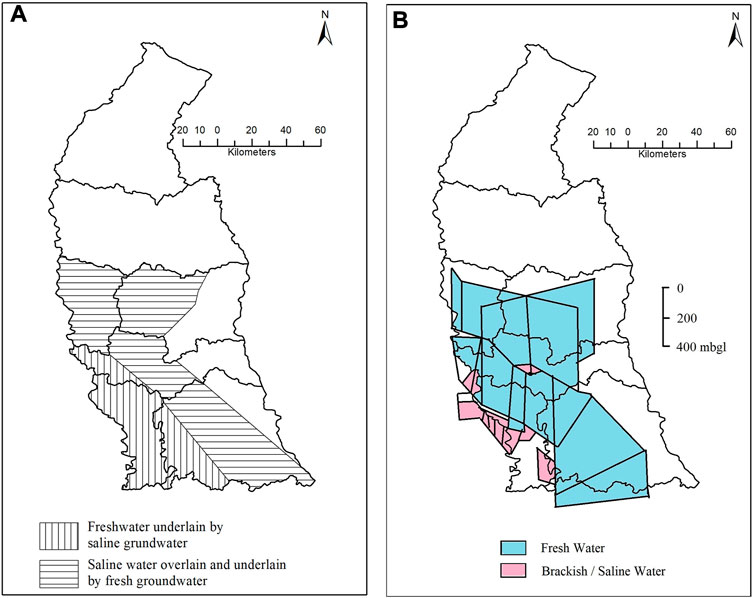
FIGURE 2. Groundwater map of Upper-Doab region of Uttar Pradesh, India showing (A) Major areas under saline aquifer, and (B) depth-wise salinity report (modified from Chadha, 2016).
Around 70 groundwater samples from hand pump IM-II tapping phreatic aquifers have been collected from Groundwater Monitoring Stations (GWMS) established by the Central Groundwater Board (CGWB), Lucknow during the pre-monsoon period of 2021. The samples were carried in tightly sealed tarson bottles, and utmost care was taken for the samples to reach the laboratory, where the samples were analyzed as per the standard method (APHA, 2005) for bicarbonate (HCO3), sulphate (SO4), chloride (Cl), fluoride (F), nitrate (NO3), total hardness (TH), calcium (Ca), magnesium (Mg), sodium (Na) and potassium (K). The potential of hydrogen (pH) and electrical conductivity (EC) was measured in situ by pH and EC meters, respectively. The titrimetric method was applied for measuring HCO3, Ca, and Mg concentration. Whereas, a flame-photo meter was used to measure Na and K concentration. The spectrophotometric method was used to measure F, NO3, and SO4 concentration, and Mohr’s for Cl concentration (Nijesh et al., 2021).
Water Quality Index (WQI) is a quality rating method widely used to show the composite influence of all the water quality parameters based on the quality rating scale (Qn) of each parameter and their unit weight (Wn) (Atta et al., 2022; Alsheri and Abdelrahman, 2023). Then a single score is generated to represent the water quality for domestic purposes. Weighted Arithmetic Water Quality Index (WAWQI) is one of the well-established methods to analyze water quality for domestic purposes in which Qn is calculated using Eq. 1 and the Wn is calculated using Eq. 2 which depends upon the standard value of each parameter as prescribed by WHO (2011) (Gharibi et al., 2019; Gautam et al., 2021). The final calculation for determining the water quality is calculated using Eq. 3.
Where Qn is the quality rating scale for nth water quality parameter, Cn is the observed value of nth parameter, Sn is the standard value of nth parameter, Wn is the unit weight for nth parameter, and K is the proportionality constant, calculated by

TABLE 1. Quality standard, and unit weight for each parameter in WAWQI for groundwater samples in the Upper-Doab region of Uttar Pradesh, India.
Groundwater suitability for irrigation has been calculated using indices such as Residual Sodium Carbonate (RSC) (Eq. 4), Sodium Adsorption Ratio (SAR) (Eq. 5), Sodium Percentage (%Na) (Eq. 6), Permeability Index (PI) (Eq. 7), Kelly Ratio (KR) (Eq. 8), Magnesium Hazard (MH) (Eq. 9), Potential Salinity (PS) (Eq. 10), Irrigation Coefficient (Ka) (Eq. 11) and Synthetic Harmful Coefficient (K) (Eq. 12). These indices are based on the comparative ionic composition of various physico-chemical parameters present in the groundwater.
Where all ionic concentrations are expressed in meq/L
Where M represents the TDS (in g/L).
Further, the present study has used Composite Groundwater Quality Index for Irrigation (CGQII) method to have a single score to decide groundwater suitability for irrigation (Gautam et al., 2021). CGQII for each groundwater sample has been calculated using the following formulas:
Where, Qn is the quality rating scale for nth irrigation index, Cn is the observed value of nth irrigation index. Sn is the standard value of nth irrigation index, Wn is the unit weight for nth irrigation index, and K is the proportionality constant, calculated as similar to WAWQI. The standard limit, the proportionality constant, and the unit weight for each irrigation index have been mentioned in Table 2.
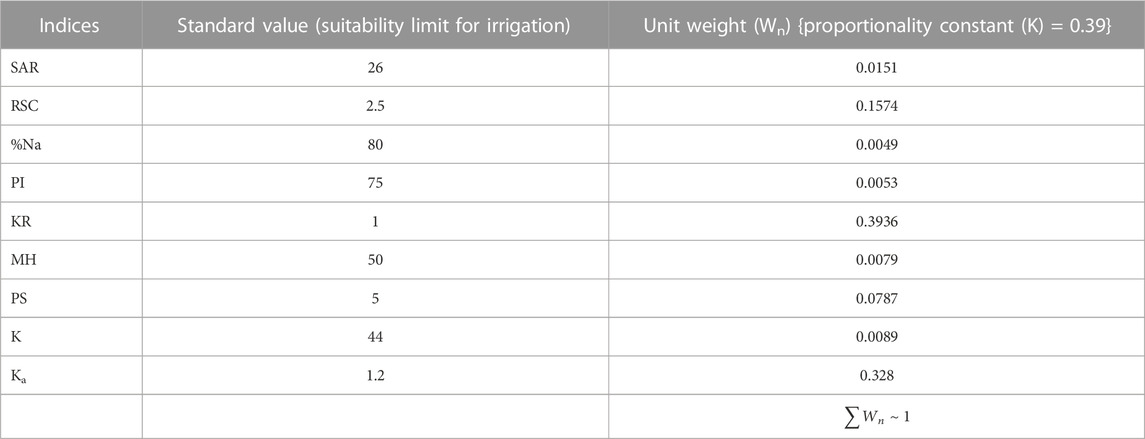
TABLE 2. Standard value, proportionality constant (K), and unit weight (Wn) of various indices for CGQII (Gautam et al., 2021).
The analytical results of groundwater samples of the Upper-Doab region of Uttar Pradesh have been presented in Table 3. The largest variation has been recorded in EC, TH, HCO3, Na, and Cl concentrations among all the Physico-chemical parameters in groundwater samples of the region. Overall, the ionic dominance in the groundwater samples is in the order of HCO3 > Cl > SO4 > NO3 > F and Na > Mg > Ca > K. However, this sequence of dominance is not uniform in all the samples. A few samples have higher chloride concentrations than bicarbonate, and a few samples have higher nitrate than sulphate.
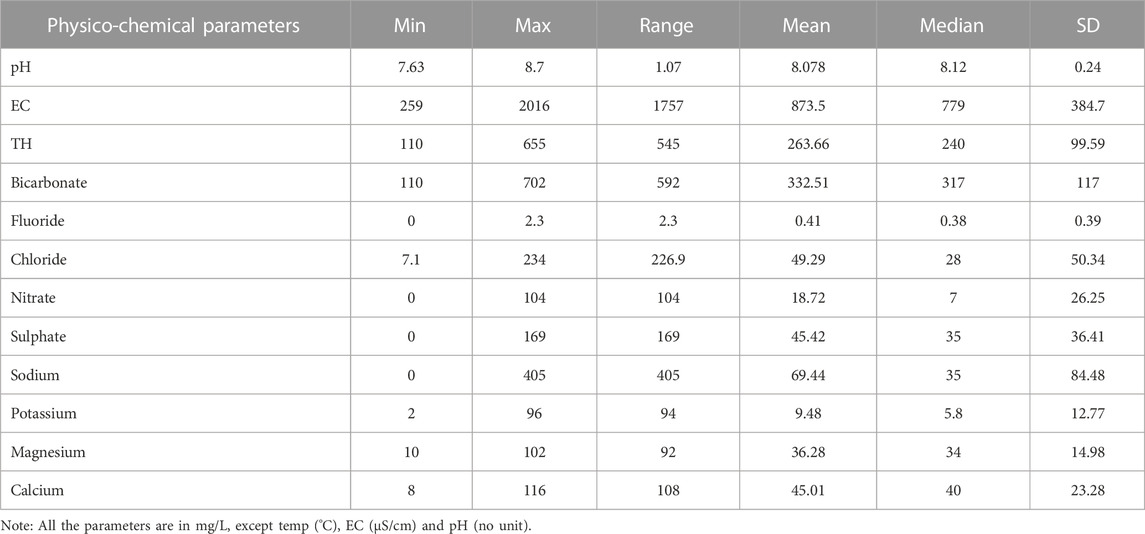
TABLE 3. Statistical summary of physico-chemical parameters of groundwater samples of the Upper-Doab region of Uttar Pradesh, India.
Based upon the chemical concentration in the groundwater samples, the chemical history of groundwater samples was determined using a piper-trilinear diagram (Figure 3). It shows that most of the groundwater samples lie in the 1st and 3rd quadrants of the diamond plot. This shows that Ca-Mg-HCO3 and Ca-Na-HCO3 types of groundwater are mostly found in this region. Similar kinds of groundwater facies have also been reported by Nijesh et al. (2021) while assessing the hydrochemical characteristics of groundwater under similar hydrogeological conditions in the Upper Ganga plain of Uttar Pradesh, India. Apart from these, Na-HCO3 types of groundwater have also been reported, mainly in the Baghpat and Gautam Buddha Nagar districts of the region. The same groundwater facies has also been reported in the groundwater around the Hindon river basin, which drains in the south-western parts of the study area forming a major part of the alluvial plains of Gautam Buddha Nagar district (Ahamad and Khurshid, 2019). The reason for Na-HCO3 types of groundwater is both anthropogenic and geological. On one hand, the massive extraction of groundwater to meet agricultural and domestic needs of urban population has led to lowering of groundwater table to around 45 mbgl (CGWB, 2022); and on the other, loose quaternary deposits of sand, silt, gravel and pebbles provide a suitable condition for infiltration and penetration of rainwater, irrigation flows and urban discharge. A part of this infiltrated water penetrates into the basement rocks of the discharge zone and interacts with aluminosilicates rocks present there, resulting in the formation of Na-HCO3 types of groundwater (Borzenko et al., 2019).
Gibb’s plot best illustrates the functional sources attributing chemical constituents to the groundwater. The analysis reveals that rock-water interaction was dominantly controlling the ionic composition of the groundwater in the unconfined aquifer environment. However, at a few places in shallow aquifers, the evaporation effect was also dominant (Figures 4A, B). Further, the bivariate plot of (SO4 + HCO3) vs. (Ca + Mg) has been used to understand the mechanism of ion exchange between the groundwater and its host unconfined aquifer environment. The results reveal that most of the samples lie along the 1:1 line (Figure 5). This suggests that the weathering of calcite and dolomite minerals present in the aquifer environment of the alluvial plain has largely attributed chemical character to the groundwater of the region (Gautam et al., 2022; Yao et al., 2022). However, in about 10% of the groundwater samples of Meerut, Ghaziabad, and Gautam Buddha Nagar districts, the process of ion exchange has been found dominant due to excess sulphate or bicarbonate. This suggests the process of silicate weathering in the clayey aquifer environment of the region. Apart from this natural cause, there is a greater chance of ion-exchange between calcium and magnesium from carbonate minerals and sodium from groundwater of the urban areas, as Ghaziabad and Gautam Buddha Nagar are the highly urbanized and industrialized districts of the region being located near-to and towards groundwater flow direction of National capital of Delhi.
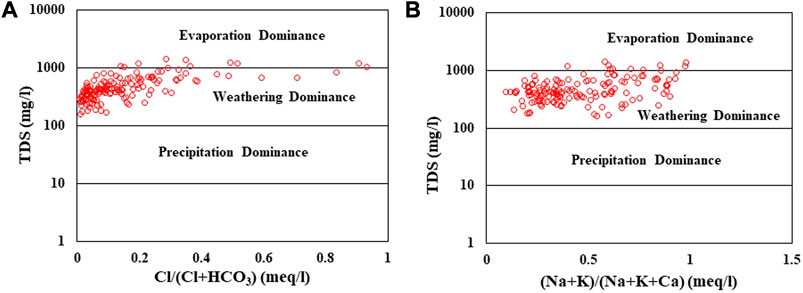
FIGURE 4. Gibbs plot showing mechanism controlling groundwater chemistry of Upper-Doab region, Uttar Pradesh, India.
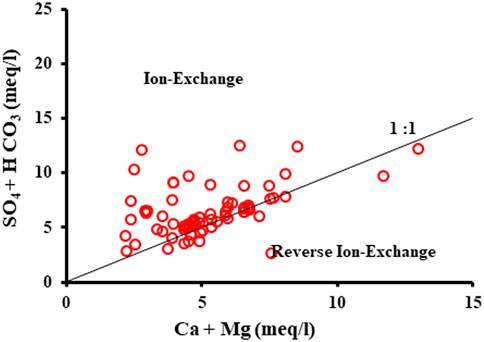
FIGURE 5. Biplots of (SO4 + HCO3) vs. (Ca + Mg) of groundwater samples of Upper-Doab region, Uttar Pradesh, India.
The intake of various ions is crucial for the proper functioning of body metabolism. However, human health is very sensitive to the intake of the amount of ionic concentration. Even the small presence of trace elements and other organic pollutants can be potentially severe to human health. Highly acidic water can cause digestive problems for humans by reducing insulin sensitivity in case of lower pH and inducing whole-body acid-base imbalance (Hansen et al., 2018). Results reveal that the pH of groundwater ranges between 7.6 and 8.7 (Table 3), which is acceptable for domestic use. High salinity (measured by EC) above 1,000 µS/cm has been recorded in the groundwater samples of Baghpat, Chaprauli, Binauli, Pilana, Khekra, Sikandrabad, Shikarpur, Jewar, Loni, Razapur, Bhojpur, Meerut, Sardhana, Burdhana, Charthawali and Nakur, which invites greater human concern, as high salinity in water affects blood circulation in humans (BIS, 2012). Calcium greater than permissible limit of 75 mg/L were reported in the groundwaters of Loni, Hastinapur, Sardhana, Charthawal, Nakur and Sadauli Qudim, where continuous intake of highly concentrated calcium water may cause digestive disorder, dehydration, diarrhoea etc. (Bhuiyan and Ray, 2017). Higher magnesium concentration (>50 mg/L) were reported at only two places i.e., Sardhana and Sarsawa, where people might be infected with kidney dysfunction and acute renal failure (Swaminathan, 1998). Higher intake of sodium in drinking water may be associated with hypertension and chronic kidney disease (Fadeeva, 1971; BIS, 2012; Bhuiyan and Ray, 2017). The study found that groundwaters at a few places in Gautam Buddha Nagar and Bulandshahr districts have reported higher sodium concentration, where people are susceptible to these diseases associated with higher intake of sodium ion. To assess the suitability of groundwater for domestic consumption, sometimes the spatial distribution of individual ions is considered. However, it has been found arbitrary that a groundwater sample is found suitable for domestic use considering calcium, and unsuitable when considering sodium ion concentration. Therefore, to have a single score for assessing the quality of water, WAWQI has been widely used in the research domain that considers the proportionate value of all the ions considered for assessing water quality (Adimalla and Qian, 2019; Ren et al., 2022). Results reveal that about 10% of the groundwater in the region was found poor to unsuitable for domestic use (Table 4). This includes areas of Gautam Buddha Nagar, Baghpat, and Muzaffarnagar districts (Figure 6).

TABLE 4. Classification of groundwater for domestic purposes in the Upper-Doab region of Uttar Pradesh, India (percentage in parentheses).
This is largely due to the higher concentration of nitrate and potassium in Baraut (Baghpat), and Khandhal, Shamli (Muzaffarnagar), and sodium and fluoride in Dankaur (Gautam Buddha Nagar). The source of higher concentrations of these minerals are natural (fluorite minerals, silicate minerals, and evaporite deposits), and anthropogenic (excessive groundwater extraction, untreated waste discharge and excessive fertilizers in agriculture) both.
Groundwater could be analyzed for domestic consumption considering individual ions or all ions as in WAWQI; but for evaluating groundwater suitability for irrigation purposes, the relative concentration of one ion over the other is the most significant. Therefore, about nine indices have been used in various studies analyzing the groundwater status for irrigation purposes. The present study also analyses the groundwater suitability for irrigation using all these indices one by one, each having a specific significance.
RSC calculates the excess of CO2 and HCO3 over Ca and Mg combined. This tends to the precipitation of calcium and magnesium. The very high value of RSC gives rise to the possibility of sodium ion adsorption, especially in clayey soil having a high capacity for cation exchange (Singh et al., 2008). This may further lead to the deposition of sodium carbonate making the soil alkaline and reducing soil productivity (Das and Nag, 2015). Results reveal that only about 33% of the region has good quality groundwater concerning RSC, and about 39% of the groundwater has been found unsuitable for the use of irrigation purposes (Table 5). The areas included in the unsuitable category are southwestern parts including Gautam Buddha Nagar, Ghaziabad, Baghpat, Meerut, and Bulandshahr districts (Figure 7A). SAR considers excess sodium ion over calcium and magnesium combined. Its higher concentration affects the growth of seedlings and crop productivity (Nagaraju et al., 2016). About 98% of the groundwater samples were under the excellent category, which is a good sign for higher crop productivity (Table 5). However, it was found higher in the southern parts of Gautam Buddha Nagar district (Figure 7B). Sodium Percentage is another index to measure sodium hazard in groundwater. Results reveal that about 21% of the region in the south-western parts has higher sodium concentration in comparison to the total cations present in the groundwater, making it unsuitable for use (Table 5; Figure 7C). This may alter soil structure, and reduce soil permeability and aeration (Bouderbala, 2017). Sodium value more than calcium and magnesium combined also makes groundwater unsuitable for irrigation as calculated by KR. As per this index, about 41% of the area in south-western parts has groundwater unsuitable for irrigation (Table 5; Figure 7D). Groundwater with a high concentration of calcium, magnesium, sodium, and bicarbonate should not be used for irrigation for a longer period (Gautam et al., 2021). A groundwater sample having a PI value of 75% or above the maximum permissible limit is considered suitable for the use of irrigation (Class I and II); whereas, below 25% of maximum permeability makes it unsuitable for the use of irrigation (Class III) (Doneen, 1964). Results reveal that 46 groundwater samples out of 71 have been found unsuitable for irrigation use. Further, for groundwater use in irrigation, calcium, and magnesium must be in equilibrium with each other for good crop yield. Fortunately, this equilibrium has been maintained in most of the groundwater samples in the region (Table 5; Figure 7E). Otherwise, this would have resulted into hardness of the soil, reducing soil productivity (Nagaraju et al., 2016). Further analysis reveals that the groundwater of about 99%–100% of the region has been found suitable for irrigation use concerning potential salinity, synthetic harmful coefficient, and irrigation coefficient (Table 5; Figures 7F–H).
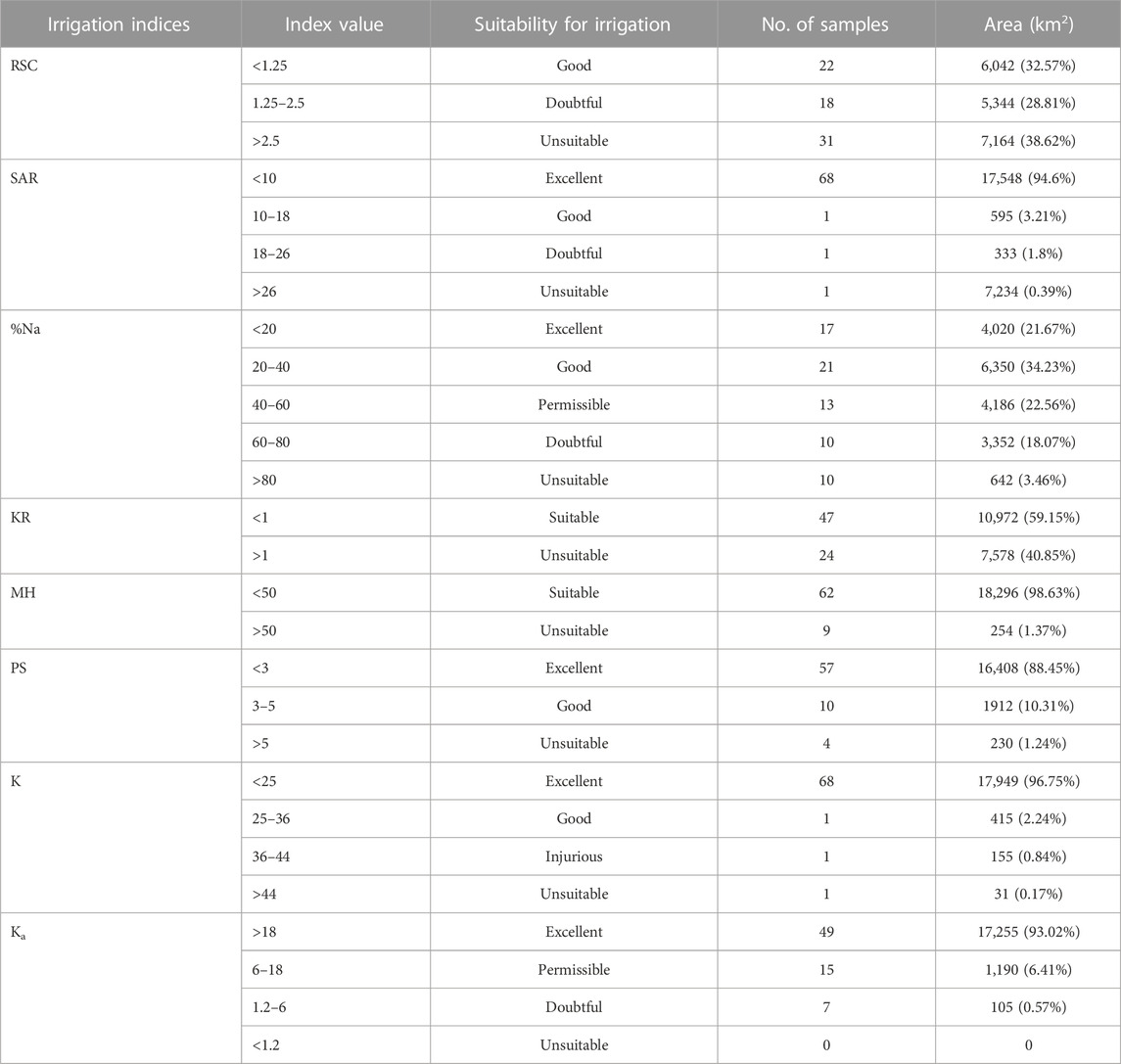
TABLE 5. Classification of groundwater for irrigation purposes in the Upper-Doab region of Uttar Pradesh, India (percentage in parentheses).
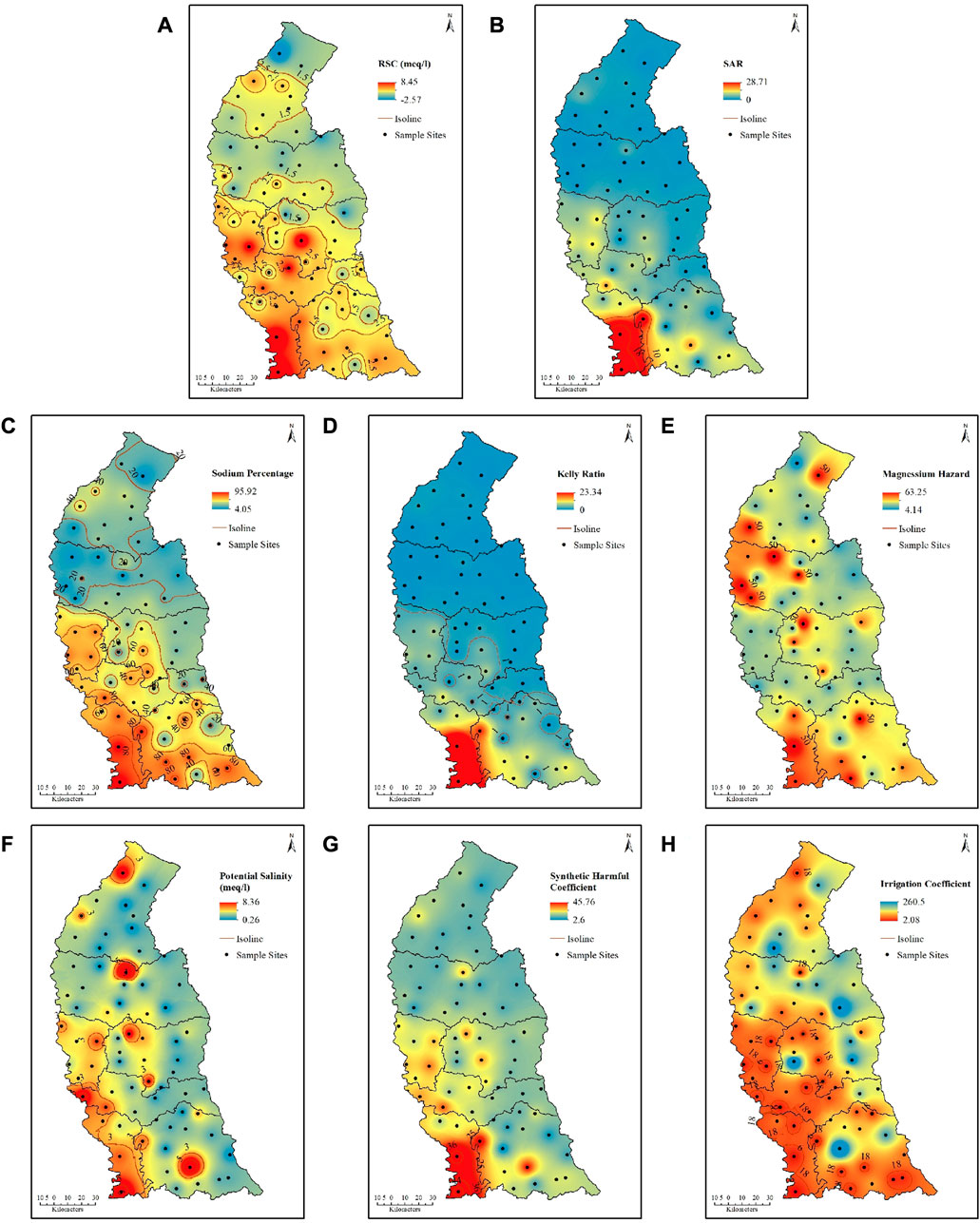
FIGURE 7. Groundwater suitability for irrigation purposes in Upper-Doab region, Uttar Pradesh, India concerning (A) RSC, (B) SAR, (C) Sodium Percentage, (D) Kelly Ratio, (E) Magnesium Hazard, (F) Potential Salinity, (G) Synthetic Harmful Coefficient, and (H) Irrigation Coefficient.
It can be noted from the discussion above that, many groundwater samples were found suitable concerning one index and found unsuitable concerning the other. Therefore, CGQII has been used to get a single score for a sample for considering its suitability for irrigation. Results reveal that groundwater of about 25% of the region including Gautam Buddha Nagar, Bulandshahr, Ghaziabad, Meerut, and Baghpat has been found unsuitable for irrigation purposes (Table 6; Figure 8). It must be noted that being nearer to National Capital of Delhi, the western region (most of Upper-Doab region) has greater levels of urbanization with Ghaziabad and Gautam Buddha Nagar district, having more than 50% of their population residing in urban areas (Raj and Singh, 2017). The region has experienced immense growth in industrial sectors after economic liberalization in 1991. Western Uttar Pradesh has a greater number of sugar mills in the districts of Muzaffarnagar, Baghpat, Meerut, and Saharanpur. Apart from this, textile industries, wooden and furniture industries, paper industries, glass industries, and brass and cement industries are also located in this region. These activities largely contribute to making the groundwater unsuitable for irrigation in the region. Similar kind of results has also been obtained in analyzing the groundwater quality in the Ghaziabad district in a separate study carried out by Chabukdhara et al. (2017). The impact of land use on the overall quality of groundwater in the Ghaziabad district of Uttar Pradesh shows that the quality of groundwater is deteriorating at an alarming rate due to improper management of land use activities (Tyagi and Sharma, 2018).

TABLE 6. Classification of groundwater for irrigation purposes in the Upper-Doab region of Uttar Pradesh, India as per CGQII (percentage in parentheses).
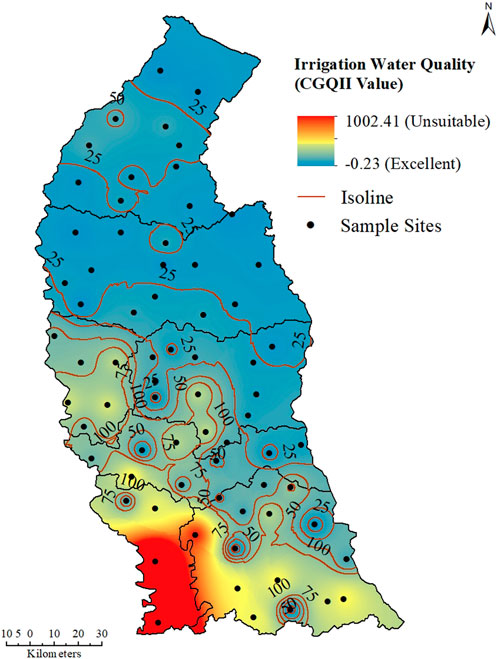
FIGURE 8. Groundwater suitability for irrigation purposes in Upper-Doab region, Uttar Pradesh, India using CGQII.
It must also be noted that the region is further experiencing many fold increase in the highway and expressway sectors with the construction of the Delhi-Meerut Expressway, under construction Delhi-Meerut Regional Rapid Transit System (RRTS) and the green-field expressway of Delhi-Dehradun traversing the whole Upper-Doab region from south to north. This would lead to a greater concentration of population and infrastructural development for industrial purposes resulting in undue pressure on the existing groundwater resources in the region concerning groundwater quality and quantity. The adverse impact of highly urbanizing areas on groundwater quality has also been reported in the developing region of the world at many places under similar geological conditions (He et al., 2009; Lu et al., 2018).
The physico-chemical analysis of groundwater in the Upper-Doab region of Uttar Pradesh, India reveals that EC and TDS in the industrial and urbanized parts of the region are above the permissive limits of WHO (2011), making it unsuitable for direct consumption. Further, calcite and dolomite weathering have been prominently found attributing chemical character to the groundwater of the region. This is similar to the chemical processes undergoing in the aquifer environment of other parts of the Indo-Gangetic plain. Further, zoning of groundwater concerning its suitability for irrigation purposes reveals that the groundwater of industrial and urban areas of Gautam Buddha Nagar, Ghaziabad, Baghpat, Meerut, and Bulandshahr have become unsuitable for irrigation. Therefore, this is high time to think about the measures to check the quality deterioration of groundwater in the region for a sustainable future for people residing in this zone. First, people must be made aware of the deteriorating groundwater quality, as no policy can be implemented successfully without people’s participation. Second, Strict laws should be made for the untreated discharge of industrial effluents into the surface water or groundwater. Third, Farmers must be made aware of the adverse health impact of using poor-quality groundwater. At last but not the least, continuous monitoring of groundwater quantity and quality is of utmost importance in the region, which might help the policy planners for devising ways and means of controlling the accelerated rate of groundwater quality deterioration in the southern parts of the region. There is also an urgent need to decelerate the pace of unsustainable infrastructural development which pose threat to the only left underground freshwater resources to meet the needs of the future generation. One of the best ways how these kind of studies and regular monitoring of groundwater resources would be helpful to the policy planners might be seen in the way of planning land-use in an area. The land where the groundwater is unsuitable for domestic consumption might be put under direct vegetation cover in order to avoid direct human consumption. Policy can be framed to punish the industrial owners who violate the rule of untreated discharge of waste water directly to either the surface water or the groundwater. Farmers can be advised to use less pesticides and grow less water consuming crops. Planners should use these research results to demarcate areas having good quality groundwater under residential sector, and set up industrial areas in those places which do not have direct link to impact the quality of groundwater in the residential areas.
The raw data supporting the conclusion of this article will be made available by the authors, without undue reservation.
AG collected the data and analyzed the data using statistical techniques and writing the manuscript. SCR completed the writing and review work.
The authors are thankful to the Head, Department of Geography for providing facilities. The first author is grateful to the Principal, Shaheed Bhagat Singh Evening College, University of Delhi for infrastructural support for the completion of this study.
The authors declare that the research was conducted in the absence of any commercial or financial relationships that could be construed as a potential conflict of interest.
All claims expressed in this article are solely those of the authors and do not necessarily represent those of their affiliated organizations, or those of the publisher, the editors and the reviewers. Any product that may be evaluated in this article, or claim that may be made by its manufacturer, is not guaranteed or endorsed by the publisher.
Adimalla, N., and Qian, H. (2019). Groundwater quality evaluation using water quality index (WQI) for drinking purposes and human health risk (HHR) assessment n an agricultural region of Nanganur, South India, Exotoxico. Environ. Saf. 176, 156–161.
Ahmad, S., and Khurshid, S. (2019). Hydrogeochemical assessment of groundwater quality in parts of the hindun river basin, Ghaziabad India: Implications for domestic and irrigation purposes. SN Appl. Sci. 1, 151.
Alsheri, F., and Abdelrahman, K. (2023). Integrated approach for investigation of groundwater quality using hydrochemical and geostatistical analysis in Wadi Fatimah, Western Saudi Arabia. Front. Earth Sci. 11, 1166153.
Amiri, V., Rezaet, M., and Sohrabi, N. (2014). Groundwater quality assessment using entropy weighted water quality index (EWQI) in Lenjanat, Iran. Environ. Earth Sci. 72, 3479–3490. doi:10.1007/s12665-014-3255-0
Aouiti, S., Azaza, F. H., Meilki, F. E., Hamdi, M., Celico, F., and Zammouri, M. (2021). Groundwater quality assessment for different uses using various water quality indices in semi-arid region of Central Tunisia. Environ. Sci. Poll. Res. 28, 46669–46691. doi:10.1007/s11356-020-11149-5
APHA (2005). Standard methods for the examination of water and waste water. 20th edn. Washington DC: American Public Health Association.
Atta, H. S., Omar, M. A. S., and Tawfik, A. M. (2022). Water quality index for assessment of drinking groundwater purpose case study: Area surrounding ismailia canal, Egypt. Appl. Sci. 69, 83. doi:10.1186/s44147-022-00138-9
Bhuiyan, C., and Ray, P. K. C. (2017). Groundwater quality zoning in the perspective of health hazards. Water Res. manage. 31, 251–267. doi:10.1007/s11269-016-1522-4
BIS (2012). Indian standard drinking water specification. New Delhi: Bereau of Indian Standard. second revision ISO: 10500:2012.
Bonsor, H. C., MacDonald, A. M., Ahmed, K. M., Burgess, W. G., Basharat, M., Calow, R. C., et al. (2017). Hydrogeological typologies of the Indo-Gangetic basin alluvial aquifer, South Asia. Hydrogeol. J. 25, 1377–1406. doi:10.1007/s10040-017-1550-z
Borzenko, S., Drebot, V., and Fedorov, I. (2019). Chemical composition nd formation condition of NaHCO3 type of waters in the eastern Transbaikalia. E3S Web Conf. 98, 01005. doi:10.1051/e3sconf/20199801005
Bouderbala, A. (2017). Assessment of water quality index for the groundwater in the upper cheliff Plain, Algeria. J. Geol. Soc. India 90, 347–356. doi:10.1007/s12594-017-0723-7
CGWB (2022). Groundwater year book, Uttar Pradesh (2021-2022). New Delhi: Ministry of water resources, River development and Ganga rejuvinaton.
Chabukdhara, M., Gupta, S. K., Kptecha, Y., and Nema, A. K. (2017). Groundwater quality in Ghaziabad district, Uttar Pradesh, India: Multivariate and health risk assessment. Chemosphere 179 (16), 167–178. doi:10.1016/j.chemosphere.2017.03.086
Chadha, D. K. (2016). “Gangatic alluvial plain: Uniqueness of the aquifer system for food security and for carbon dioxide sequestration,” in Groundwater assessment, modelling and management. Editor M. W. P ThangarajanSingh (Boka Raton: CPC Press), 39–54.
Das, S., and Nag, S. K. (2015). Deciphering groundwater quality for irrigation and domestic purposes – A case study in suri I and II blocks, birbhum district, West Bengal, India. J. Earth Syst. Sci. 124 (5), 965–992. doi:10.1007/s12040-015-0583-8
Deshmukh, K. K. (2013). Impact of human activities on the quality of groundwater from Sangamnerarea, Ahmednagar District, Maharashtra, India. Int. J. Environ. Sci. 2 (8), 66–74.
Doneen, L. D. (1964). Notes on water quality in agriculture. Oakland, CA, USA: Department of Water Science and Engineering, University of California.
Ekbal, E., and Khan, T. A. (2022). Hydrogeochemical characterization of groundwater quality in parts of amroha district, western Uttar Pradesh, India. Hydro Res. 5, 54–70. doi:10.1016/j.hydres.2022.07.002
Emenike, P. C., Nnaji, C. C., and Tenebe, I. T. (2018). Assessment of geospatial and hydrochemical interactions of groundwater quality, southwestern Nigeria. Environ. Monit. Assess. 190, 440. doi:10.1007/s10661-018-6799-8
Fadeeva, V. K. (1971). Effect of drinking water with different chloride contents on experimental animals. Gig. I Sanit. 36 (6), 1115.
Gautam, A., Rai, S. C., and Rai, S. P. (2021). Assessment of groundwater quality beneath agriculturally advanced region of northern alluvial plain, India. Sustainability 13 (13), 7053. doi:10.3390/su13137053
Gautam, A., Rai, S. C., Rai, S. P., Ram, K., and Sanny, (2022). Impact of anthropogenic and geological factors on groundwater hydrochemistry in the unconfined aquifers of Indo-Gangetic plain. Phy. Chem. Earth 126, 103109. doi:10.1016/j.pce.2022.103109
Gharibi, A., Ali, Z. I., and Zairi, M. (2019). Groundwater suitability for drinking and agriculture purposes using irrigation water quality index and multivariate analysis: Case of sidi bouzid aquifer, central Tunisia. Environ. Earth Sci. 78, 692. doi:10.1007/s12665-019-8733-y
Graaf, I. E. M. D., Beek, R. L. P. H. V., Gleeson, T., Moosdrf, N., Schmitz, O., Sutanudjaja, E. H., et al. (2017). A global-scale two-layer transient groundwater model: Development and application to groundwater depletion. Adv. Water Res. 102, 53–67. doi:10.1016/j.advwatres.2017.01.011
Gulati, A., Terway, P., and Hussain, S. (2021). “Performance of agriculture in Uttar Pradesh,” in Revitalizing Indian agriculture and boosting farmer incomes. Editors A. Gulati, R. Roy, and S Saini (Singapore: Springer Nature), 175.
Hansen, T. H., Thomassen, M. T., Madsen, M. L., Kern, T., Bak, E. G., Kashani, A., et al. (2018). The effect of drinking water pH on the human gut microbiota and glucose regulation: Results of a randomized controlled cross-over intervention. Sci. Rep. 8, 16626. doi:10.1038/s41598-018-34761-5
He, J., Ma, T., Deng, Y., Yang, H., and Wang, Y. (2009). Environmental geochemistry of high arsenic groundwater at Western Hetao plain, Inner Mongolia. Front. Earth Sci. 3 (1), 63–72. doi:10.1007/s11707-009-0004-x
Kumar, R., Singh, S., Kumar, R., and Sharma, P. (2022). Groundwater quality characterization for safe drinking water supply in sheikhpura district of Bihar, India: A geospatial approach. Front. Water 4, 848018. doi:10.3389/frwa.2022.848018
Kumari, M., and Rai, S. C. (2020). Hydrogeochemical evaluation of groundwater quality for drinking and irrigation purposes using water quality index in semi-arid region of India. J. Geol. Soc. India 95 (2), 159–168. doi:10.1007/s12594-020-1405-4
Lalitha, M., Dharumaraja, S., Kalaiselvi, B., Shivanand, K., Kpyal, A., Kaliraj, S., et al. (2021). Hydrochemical characterisation and groundwater quality in Cauvery deltaic fluvial plains of Southern India. Environ. Sci. Pollut. Res. 28, 44881–44876.
Li, C., Men, B. H., and Yin, S. Y. (2022). Analysis of groundwater chemical characteristics and spatiotemporal evolution trend of influencing factors in souther Beijing plain. Front. Environ. Sci. 10, 913542.
Lin, X., Li, W., Bai, X., han, L., and Ming, D. (2022). Spatial variation in groundwater depletion across China under multiple stresses. Front. Environ. Sci. 10, 1067766. doi:10.3389/fenvs.2022.1067766
Lu, Y., Tang, C., Chen, J., and Yao, H. (2016). Assessment of major ions and heavy metals in groundwater: A case study from guangzhou and zhuhai of the pearl river delta, China. Earth Sci. 10 (2), 340–351. doi:10.1007/s11707-015-0513-8
Lu, Y., Zang, X., Yao, H., Zhang, S., Sun, S., and Liu, F. (2018). Assessment of trace metal contamination in groundwater in a highly urbanizing area of Shenfu New District, Northeast China. Front. Earth Sci. 12 (3), 569–582. doi:10.1007/s11707-018-0677-0
McGrane, S. (2016). Impacts of urbanisation on hydrological and water quality dynamics, and urban water management: A review. Hydrol. Sci. J. 61 (13), 2295–2311. doi:10.1080/02626667.2015.1128084
Megahed, H. A. (2020). GIS-based assessment of groundwater quality and suitability for drinking and irrigation purposes in the outlet and central parts of Wadi El-Assiuti, Assiut Governorate, Egypt. Bull. Natl. Res. Cent. 44, 187. doi:10.1186/s42269-020-00428-3
MoEF (2009). Status paper on river Ganga, state of environment and water quality. New Delhi: national rural Conservation Directorate Ministry and Environment and Forests, Government of India.
Nagaraju, A., Murlidhar, P., and Sreedhar, Y. (2016). Hydrogeochemistry and groundwater quality assessment of rapur area, Andhra Pradesh, south India. J. Geosci. Environ. Prot. 4, 88–99. doi:10.4236/gep.2016.44012
Nijesh, P., Akpataku, K. V., Patel, A., Rai, P., and Rai, S. P. (2021). Spatial variability of hydrochemical characteristics and appraisal of water quality in stressed phreatic aquifer of Upper Ganga Plain, Uttar Pradesh, India. Earth Sci. 80, 185. doi:10.1007/s12665-021-09410-2
Pant, N., Rai, S. P., Singh, R., Kumar, S., Saini, R. K., Purushottam, P., et al. (2021). Impact of geology and anthropogenic activities over the water quality with emphasis on fluoride in water scarce Lalitpur district of Bundelkhand region, India. Chemosphere 279, 130496. doi:10.1016/j.chemosphere.2021.130496
Patel, A., Rai, S. P., Akpataku, K. V., Nijesh, P., Singh, A. K., Pant, N., et al. (2023). Hydrogeochemical characterization of groundwater in the shallow aquifer system of Indo-Gangatic basin. India: Groundwater Sustain Develop.
Prasad, R. K., Sharma, A., Mehrotra, P., and Arun, D. N. (2015). Groundwater year book, Uttar Pradesh. Delhi: CGWB, p169.
Prasad, R. K., Sharma, A., Mehrotra, P., and Arun, D. N. (2016). Groundwater year book, Uttar Pradesh. Delhi: CGWB, p263.
Rai, S. C., and Saha, A. K. (2015). Impact of urban sprawl on groundwater quality: A case study of faridabad city, national capital region of Delhi. Arab. J. Geosci. 8 (10), 8039–8045. doi:10.1007/s12517-015-1811-x
Rai, S. C. (2011). Water management for a megacity: National capital territory of Delhi. Water Resour. Manag. 25, 2267–2278. doi:10.1007/s11269-011-9807-0
Raj, K., and Singh, A. K. (2017). Urbanization in Uttar Pradesh: A geographical analysis. Goa Geogr. 14 (1), 57–68.
Raju, N. J., Patel, P., Gurung, D., Ram, P., Gossel, W., and Wycisk, P. (2015). Geochemical assessment of groundwater quality in the Dun valley of central Nepal using chemometric method and geochemical modeling. Groundw. Sustain. Dev. 1 (1-2), 135–145. doi:10.1016/j.gsd.2016.02.002
Ramalingam, S., Panneerselvam, B., and Kaliappan, S. P. (2022). Effect of high nitrate contamination of groundwater on human health and water quality index in semi-arid region, South India. J. Geosci. 15, 242. doi:10.1007/s12517-022-09553-x
Ren, X., Yu, R., Kang, J., Li, X., Wang, R., Zhuang, S., et al. (2022). Hydrochemical evaluation of water quality and its influencing factors in a closed intake lake basin of Northern China. Front. Ecol. Evol. 16, 1005289.
Scheiber, L., Cendon, D. I., Lverach, C. P., Hankin, S. I., Sune, E. V., and Kelly, B. F. J. (2020). Hydrochemical apportioning of irrigation groundwater sources in an alluvial aquifer. Sci. Total Environ. 744, 140506. doi:10.1016/j.scitotenv.2020.140506
Schmidt, J. J. (2017). Water: Abundance, scarcity, and security in the age of humanity. New York: New York University Press.
Shiferaw, B. (2021). Addressing groundwater depletion: Lessons from India, the world’s largest user of groundwater. Tharamani, Chennai: Indipendent Evaluatiob Group, World bank Group.
Singaraja, C. (2017). Relevance of water quality index for groundwater quality evaluation: Thoothukudi district, Tamil Nadu, India. Appl. Water Sci. 7, 2157–2173. doi:10.1007/s13201-017-0594-5
Singh, A. K., Mondal, G. C., Kumar, S., Singh, T. B., Tewari, B. K., and Sinha, A. (2008). Major ion chemistry, weathering processes and water quality assessment in upper catchment of Damodar River basin, India. Environ. Geol. 54, 745–758. doi:10.1007/s00254-007-0860-1
Singh, U. V., Abhishek, A., Singh, K. P., Dhakate, R., and Singh, N. P. (2014). Groundwater quality appraisal and its hydrochemical characterization in Ghaziabad (a region of indo-gangetic plain), Uttar Pradesh, India. Appl. Water Sci. 4 (2), 145–157. doi:10.1007/s13201-013-0137-7
Swaminathan, R. (1998). “Hypo-hyper-magnesaemia,” in Oxfprd textbook of nephrology. Editors A. M. davison, J. S. Cameron, J. P. Gunfield, D. N. S. kerr, and E Ritz. 2nd edition (Oxford: Oxford University Press).
Tyagi, S., and Sharma, K. (2018). Assessment of groundwater quality in different land uses in Ghaziabad district of Uttar Pradesh, India. Environ. Int. J. Sci. Tech. 13, 99–117.
Varol, S., and Davraz, A. (2014). Evaluation of the groundwater quality with WQI (water quality index) and multivariate analysis: A case study of the tefenni plain (burdur/Turkey). Earth Sci. 73, 1725–1744. doi:10.1007/s12665-014-3531-z
Wu, F., and Butz, W. P. (2004). The future of genetically modified crops: Lessons from green revolution. Santa Monica: RAND Corporation.
Xu, P., Feng, W., Quan, H., and Zhang, Q. (2019). Hydrogeochemical characterization and irrigation quality assessment of shallow groundwater in the central-western guanzhong basin, China. Int. J. Environ. Res. Public Health 16 (9), 1492. doi:10.3390/ijerph16091492
Yao, R., Yan, Y., Wei, C., Luo, M., Xiao, Y., and Zhang, Y. (2022). Hydrochemical characteristics and groundwater quality assessment using an integrated approach of the PCA, SO4, and fuzzy c-means clustering: A case study in the northern sichuan basin. Front. Environ. Sci. 10, 907872. doi:10.3389/fenvs.2022.907872
Keywords: physico-chemical analysis, groundwater quality, WAWQI, CGQII, groundwater monitoring
Citation: Gautam A and Rai SC (2023) Hydrogeochemical characterization and quality assessment of groundwater resources in the Upper-Doab region of Uttar Pradesh, India. Front. Environ. Sci. 11:1193979. doi: 10.3389/fenvs.2023.1193979
Received: 28 March 2023; Accepted: 11 April 2023;
Published: 09 May 2023.
Edited by:
Deepak Kumar, University at Albany, United StatesReviewed by:
Varun Joshi, Guru Gobind Singh Indraprastha University, IndiaCopyright © 2023 Gautam and Rai. This is an open-access article distributed under the terms of the Creative Commons Attribution License (CC BY). The use, distribution or reproduction in other forums is permitted, provided the original author(s) and the copyright owner(s) are credited and that the original publication in this journal is cited, in accordance with accepted academic practice. No use, distribution or reproduction is permitted which does not comply with these terms.
*Correspondence: Suresh Chand Rai, cmFpc2MxOTU4ZHVAZ21haWwuY29t
Disclaimer: All claims expressed in this article are solely those of the authors and do not necessarily represent those of their affiliated organizations, or those of the publisher, the editors and the reviewers. Any product that may be evaluated in this article or claim that may be made by its manufacturer is not guaranteed or endorsed by the publisher.
Research integrity at Frontiers

Learn more about the work of our research integrity team to safeguard the quality of each article we publish.